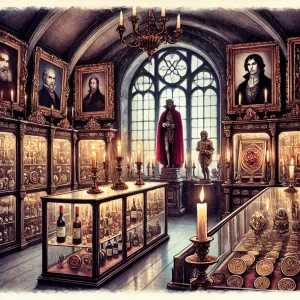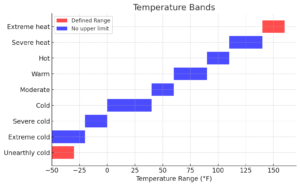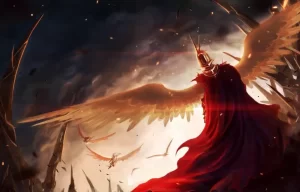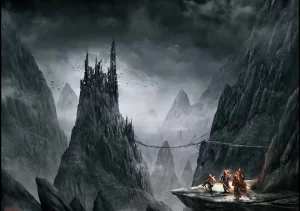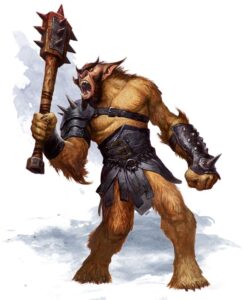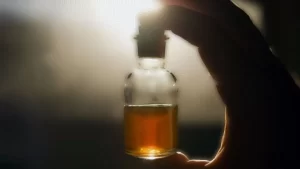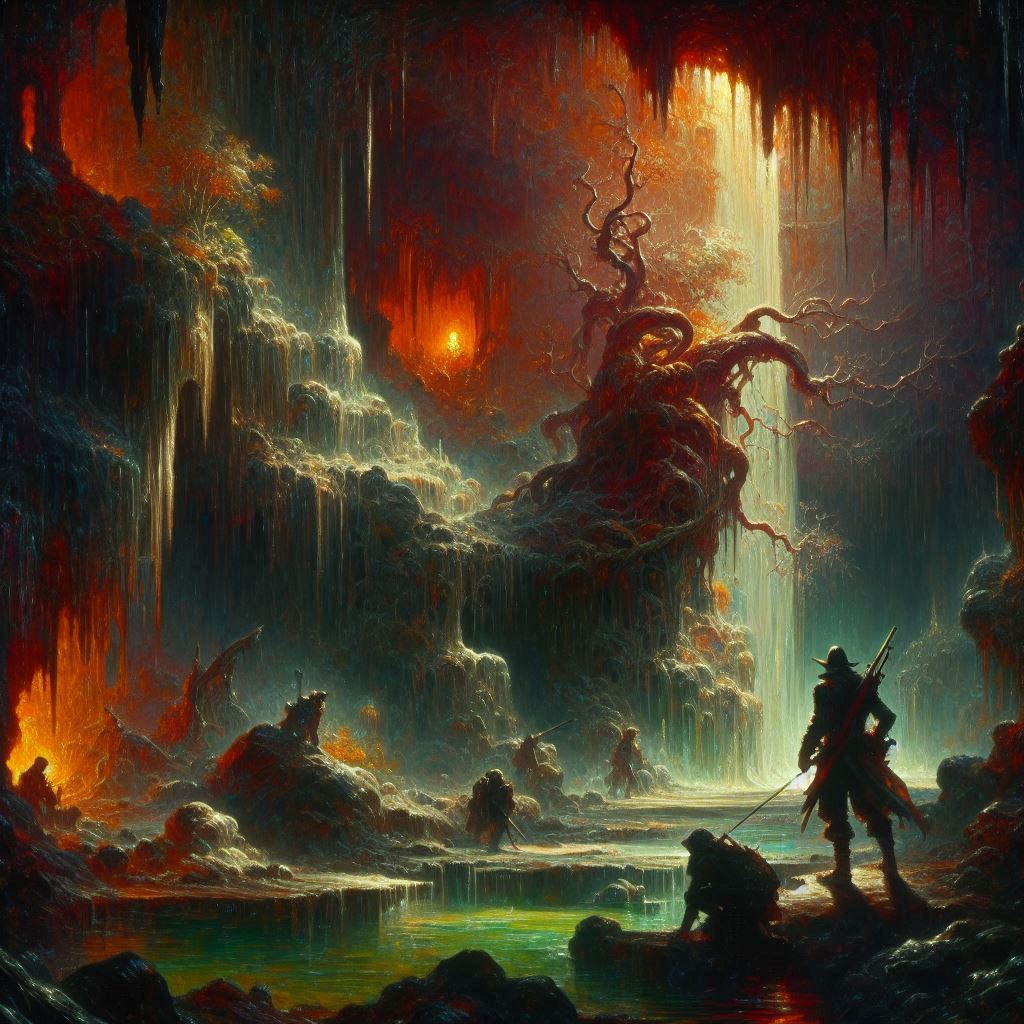
The Underdark, a vast subterranean network of interconnected caverns and tunnels, stretches beneath the surface worlds of both Dungeons & Dragons (D&D) and Pathfinder 2e. This dark, often forgotten realm is not just a place of peril and mystery, but also a vibrant ecosystem teeming with life, magic, and ancient secrets. This article dives deep into the ecology of the Underdark, exploring how its unique environments shape the creatures and cultures that dwell within.
The Environmental Zones of the Underdark
The Underdark can be divided into several ecological zones, each characterized by different geological features, flora, fauna, and environmental challenges:
The Upper Reaches: Closest to the surface, these areas are often the most accessible to surface dwellers but are fraught with dangers from both natural hazards and territorial creatures. Here, fungi forests thrive, supported by decaying organic matter from above and providing food for a variety of creatures.
The Middle Tiers: Deeper and darker, this zone is marked by large, sprawling caverns and deep lakes fed by underground rivers. Bioluminescent fungi and plants light these caverns in eerie glows, creating a unique visual landscape that supports a diverse aquatic and terrestrial life.
The Lower Depths: At the deepest levels, the heat from the earth's core creates a subterranean hellscape with magma flows and sulfuric vents, home to some of the most exotic and dangerous creatures in the Underdark.
Flora and Fauna of the Underdark
The flora of the Underdark is largely composed of fungi and other organisms adapted to low-light environments. Giant mushrooms, phosphorescent lichens, and myconids (sentient fungi) dominate, forming the basis of the food chain.
The fauna includes a range of adapted creatures, from the infamous drow, duergar, and mind flayers, who have carved out vast underground cities, to the predatory hook horrors and illithids that stalk the dark. Unique to the Underdark are the Beholders, enigmatic and terrifying beings whose magical abilities and tyrannical behaviors affect the ecosystems around them.
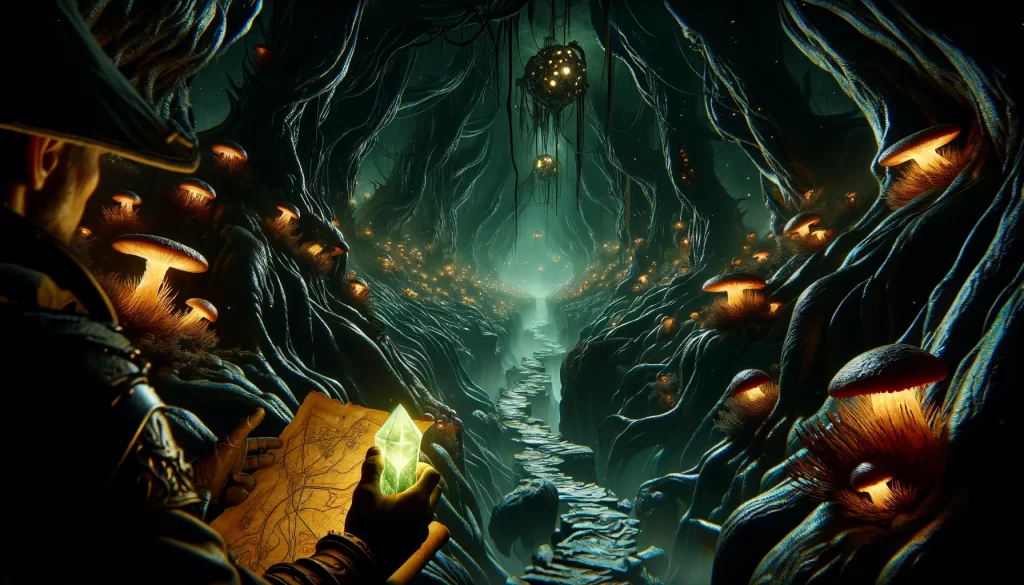
Survival and Adaptation
Creatures of the Underdark have evolved various adaptations to survive in harsh environments. Bioluminescence is common in both flora and fauna, used for attracting mates, luring prey, or deterring predators. Many animals possess enhanced senses such as echolocation or heightened olfactory senses to navigate and hunt in the darkness.
Camouflage is another critical survival trait. The ability to blend seamlessly into fungal forests, jagged rocks, or glowing crystal formations helps predators ambush prey and allows prey to avoid becoming a meal. Some creatures, like the chameleon-like cloakers or the stealthy darkmantles, can virtually disappear against the stone walls and ceilings of the Underdark.
Extreme resilience to toxins and magical radiation is also widespread. Many fungi and pools of water in the Underdark are laced with poisons or arcane energies, and native species often develop immunities or even use these dangers to their advantage. Certain species feed off these hazards directly or secrete similar substances as a defense mechanism.
Social adaptation is just as vital as physical mutation. Intelligent species like drow, duergar, and deep gnomes form complex societies centered on hierarchy, secrecy, and resource control. These civilizations often rely on ruthless efficiency, elaborate spy networks, and brutal retribution to maintain stability in a world where mercy is a luxury.
Reproduction and development have also been shaped by the Underdark's threats. Many species lay eggs in protected, out-of-the-way crevices or raise their young communally to improve odds of survival. Rapid maturation and short gestation cycles are common, allowing populations to recover from the high mortality rate that defines life in this unforgiving realm.
The Role of Magic
Magic in the Underdark has a profound influence on its ecology. Natural ambient magic from leylines and mineral deposits can cause mutations and give rise to magical creatures like the purple worm or the rare and deadly shadow dragon. Druids and rangers might find their spells influenced by the potent magical energies, altering their effects or enhancing their potency.
In tabletop role-playing games like Pathfinder 2e, D&D 5e, and AD&D, the magical nature of the Underdark creates unique gameplay challenges. In some campaigns, the weave of magic is distorted underground, causing spells like teleport, sending, or scrying to fail or behave erratically. This compels adventurers to rely more on physical exploration, local guides, or ancient magical artifacts designed to bypass these barriers.
Arcane casters may encounter places where the raw magic saturating the stone itself enhances spell potency - but not without risk. Wild magic surges, spell feedback, or even arcane poisoning can result from careless casting near unstable leyline nodes. In contrast, divine casters may experience surges in power when aligned with Underdark deities such as Lolth, Ghaunadaur, or even Torog, while others may feel cut off entirely if their god's domain is distant from the shadowed realms below.
Magic also acts as a social and political tool. Drow noble houses, for example, often rise in prominence due to their mastery of arcane or divine magic, and disputes may be resolved through ritual combat or magical trials. Spellcraft is not merely a convenience in the Underdark - it is a symbol of status, a weapon of control, and a survival mechanism. For adventuring parties, mastering or adapting to these magical nuances is essential for survival in the deep places of the world.
Cultural Aspects
The societies within the Underdark, such as the drow and the duergar, are deeply influenced by their environment. They worship deities such as Lolth, the Spider Queen, who embodies the ideals of survival, ruthlessness, and dominance, echoing the harsh realities of their home. The architecture, social structures, and economies of these societies are all adapted to underground life, with trade in rare fungi, magical artifacts, and information about safe passages or water sources.
Cultural expressions in the Underdark often take on utilitarian and symbolic forms. Art, when it exists, may be sculpted from phosphorescent fungi, crystal, or stone, often doubling as arcane foci or religious icons. Songs and oral traditions reflect themes of betrayal, cunning, and sacrifice, reinforcing the value placed on secrecy and vigilance. Festivals or rites of passage are typically grim and test the resilience or loyalty of participants, ensuring only the strong and cunning advance.
Language and etiquette are equally shaped by the dangers of subterranean life. Silence, whispers, and sign languages are common in drow and duergar communication, as loud sounds can draw unwanted attention. Trust is rarely given freely, and deception is often seen as a mark of intelligence rather than immorality. As a result, Underdark diplomacy is a subtle and dangerous dance of veiled threats and cryptic bargains.
The need for survival has also led to the widespread use of slavery and indentured servitude. Many Underdark cultures see dominance over others as both a right and a necessity. Prisoners of war, surface-dwellers, and even rival clan members may be pressed into service. This practice is not only economic but also ritualistic, reaffirming social hierarchies and divine favor. Such cruelty is not seen as evil by these societies, but simply the way of life in a world where mercy is weakness and power is everything.
Comparing D&D and Pathfinder 2e
While both D&D and Pathfinder 2e portray the Underdark as a dangerous and mysterious place, there are subtle differences in how they handle its ecology. D&D often emphasizes the magical and mythical aspects, with ancient curses and divine interventions shaping the evolution of its creatures. Pathfinder 2e, meanwhile, offers a slightly more grounded approach, with a greater emphasis on the biological and ecological aspects, providing detailed descriptions of how creatures interact with their environment.
Underdark Realm
The Underdark is a realm of endless mystery and danger, a place where survival means embracing the darkness literally and figuratively. Its ecology is a complex web of interactions between magical and mundane elements, where life has adapted in incredibly diverse ways to the challenges of subterranean existence. Exploring the Underdark in a campaign can be a journey not just through a physical space, but through the very boundaries of nature and the arcane.
This exploration of the Underdark's ecology offers just a glimpse into its depths-a reminder that in the world of tabletop RPGs, even the darkest corners of the world pulse with life, awaiting the brave or foolish enough to discover their secrets. Whether as a setting for an epic campaign or a study in fictional ecology, the Underdark remains one of the most fascinating aspects of both D&D and Pathfinder 2e.
Thank you for your feedback! Let's refine the discussion of the Underdark's natural elements, particularly focusing on the fungus and other dangerous environmental features that contribute to its perilous landscape.
The Perilous Ecology of the Underdark
The Underdark, a subterranean wonder beneath the worlds of Dungeons & Dragons and Pathfinder 2e, is not merely a dark, silent world - it's an active, living environment, where danger and beauty intertwine in the form of exotic fungi and treacherous terrain. Below, we explore the complex ecosystem, with a specific focus on the natural elements that contribute to both the wonder and the hazards of this dark realm.
The ecology of the Underdark is shaped by extremes - total darkness, oppressive humidity, toxic gases, and geological instability. Massive fungal forests, glowing with bioluminescent light, provide nourishment and shelter for countless creatures, but also host deadly spores that can paralyze, blind, or infect. Pools of stagnant, mineral-rich water may sustain life or dissolve the unwary with caustic acidity. Earthquakes, gas pockets, and sudden cave-ins are not rare occurrences but part of the daily reality beneath the surface.
Predators within the Underdark have evolved with ruthless efficiency. Oozes and slimes glide through the caverns, consuming anything organic in their path. Cloakers mimic the ceiling above, descending only when prey passes below. Even the terrain itself may betray travelers - razorvine, slick rock chasms, or patches of illusion magic concealing bottomless pits all present constant threats. Life here is not just adapted to darkness, but thrives on the dangers it brings.
The Fungi of the Underdark: Beyond Illumination
While bioluminescent fungi serve as a light source in the Underdark's eternal darkness, the fungal life in this underground world plays numerous crucial roles:
Diverse Fungi Flora: Ranging from the towering zuccalmaglio's fungus trees to the tiny but deadly mushrooms known as Timmask, the fungal flora of the Underdark is diverse. Each species has adapted uniquely to the underground conditions, some thriving on decomposing organic material, while others form symbiotic relationships with the stone and mineral deposits.
Dangers Lurking in Beauty: Among the beauty lies danger. Some fungi are carnivorous, like the Violet Fungus, which uses its mobile tendrils to strike at passing creatures. Others, such as the Phosphorescent Fungi, create slippery surfaces that can conceal pits, traps, or precipices.
Spore and Poison Hazards: Many fungi in the Underdark release spores that can have hallucinogenic or even lethal effects. The infamous Gas Spore mimics the appearance of a harmless luminescent balloon but explodes when disturbed, releasing deadly spores.
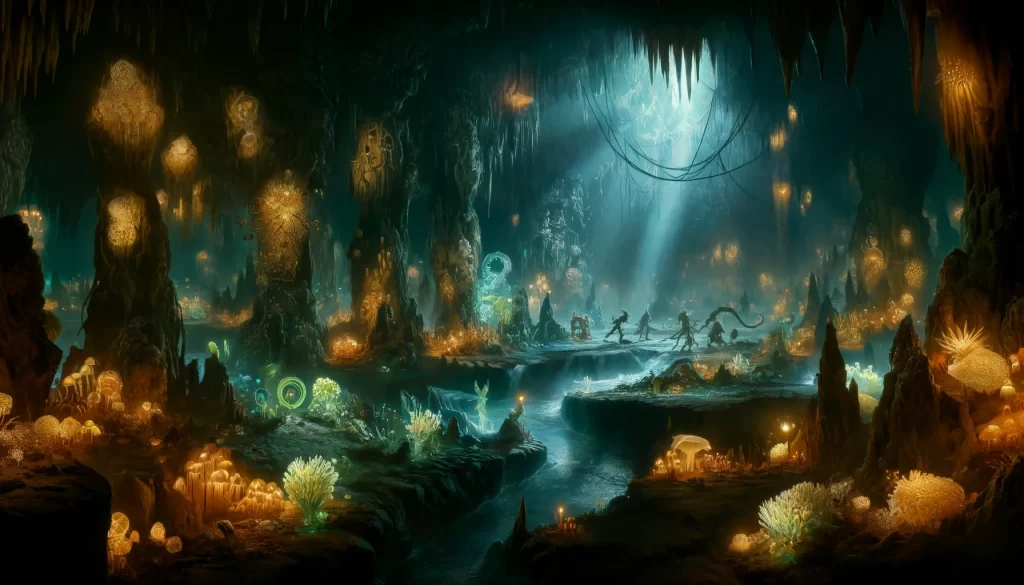
Terrain and Environmental Hazards
The geological and environmental hazards of the Underdark also play a significant role in its ecology:
Chasms and Sinkholes: The unstable terrain is riddled with sudden chasms and sinkholes that can swallow the unwary. These natural traps often become filled with other dangerous elements, like acid pools or nests of predatory creatures.
Stalactites and Stalagmites: These formations, while naturally beautiful, pose significant risks. Stalactites can fall and impale creatures below, and stalagmites can hide the movements of lurking predators.
Subterranean Rivers and Lakes: Water sources in the Underdark can be as hazardous as they are vital. Subterranean rivers might flow swiftly enough to sweep away the unprepared, while lakes can house aquatic predators or be so cold as to threaten hypothermia.
Toxic Minerals and Gases: Certain areas of the Underdark are rich in toxic minerals and gases. Pockets of sulfur, mercury vapors, and other noxious substances can pose a silent threat to health.
A Living, Breathing Underworld
This revised look at the Underdark emphasizes that it is not just a setting for adventures but a complex ecosystem with its own life cycles, dangers, and wonders. Understanding these elements can enrich gameplay, providing not only challenges but also opportunities for creative interaction with this dark and mystifying world.
By incorporating these aspects, we gain a more rounded appreciation of the Underdark's depth - both literal and ecological - making it a truly immersive backdrop for adventurers brave enough to explore its secrets.
Every creature, from the smallest glowing insect to the ancient and powerful aboleth, plays a role in this intricate subterranean web of life. Fungal blooms may signal the presence of buried predators or hint at the remnants of ancient magical catastrophes. Shifting rock formations and the distant rumbles of unknown movements remind travelers that the Underdark is not static - it grows, changes, and reacts.
To treat the Underdark merely as a collection of encounter tables is to miss its potential as a living, breathing underworld. Whether players are tracking prey through myconid groves or fleeing the territorial wrath of a roper, the Underdark rewards those who learn its rhythms and respect its secrets. Adventurers who adapt may find unlikely allies or forgotten relics - those who do not may never see the surface again.

